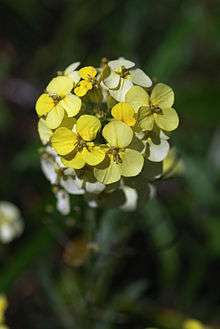Erysimum franciscanum
| Erysimum franciscanum | |
|---|---|
 | |
| Scientific classification | |
| Kingdom: | Plantae |
| (unranked): | Angiosperms |
| (unranked): | Eudicots |
| (unranked): | Rosids |
| Order: | Brassicales |
| Family: | Brassicaceae |
| Genus: | Erysimum |
| Species: | E. franciscanum |
| Binomial name | |
| Erysimum franciscanum Rossbach | |
Erysimum franciscanum, commonly known as the Franciscan wallflower or San Francisco wallflower, is a plant endemic to the northern California coast, from Sonoma to Santa Cruz Counties. It is a member of the wallflower genus in the mustard family, the Brassicaceae.
The plant is a biennial or short-lived perennial.[1][2] The flowers are cream-colored to yellow, with four sepals and four petals arranged in a cross shape, as is characteristic of the Brassicaceae.[3] It flowers from late winter to late spring.[4] The plant prefers open scrubby areas with a fair amount of sunlight, but can flourish on a range of soils including disintegrating serpentine, gravelly and sandy soils.[5] It is fairly easily cultivated in gardens.[2]
Although not formally recognized as endangered, the Franciscan wallflower has a limited, discontinuous distribution. It is monitored at the Presidio of San Francisco, which was also its type locality.[3] The plant is propagated in a nursery there and then planted in its native habitat.[2]
See also
References
External links
| Wikimedia Commons has media related to Erysimum franciscanum. |
- Jepson Manual treatment for Erysimum franciscanum
- USDA Plants Profile: Erysimum franciscanum
- Erysimum franciscanum - U.C. Photo gallery
